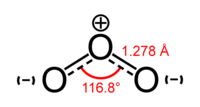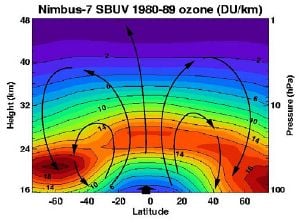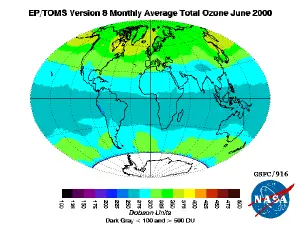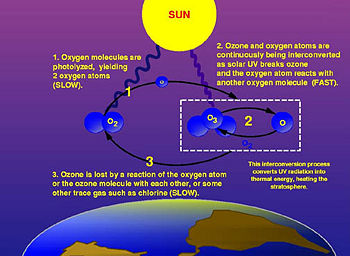Ozone
| Ozone | |
|---|---|
 
| |
| General | |
| Systematic name | Trioxygen |
| Molecular formula | O3 |
| Molar mass | 47.998 g/mol |
| Appearance | bluish colored gas |
| CAS number | [10028-15-6] |
| Properties | |
| Density and phase | 2.144 g/l (0 °C), gas |
| Solubility in water | 0.105 g/100 ml (0 °C) |
| Melting point | 75.95 K, −197.2 °C |
| Boiling point | 161.25 K, −111.9 °C |
| Thermodynamic data | |
| Standard enthalpy of formation ΔfH°solid |
+142.3 kJ/mol |
| Standard molar entropy S°solid |
237.7 J.K−1.mol−1 |
| Hazards | |
| EU classification | not listed |
| NFPA 704 | |
| Supplementary data page | |
| Structure and properties |
n, εr, etc. |
| Thermodynamic data |
Phase behaviour Solid, liquid, gas |
| Spectral data | UV, IR, NMR, MS |
| Regulatory data | Flash point, RTECS number, etc. |
| Except where noted otherwise, data are given for materials in their standard state (at 25°C, 100 kPa pressure) Infobox disclaimer and references | |
Ozone (O3) is a triatomic molecule consisting of three oxygen atoms. It is an allotrope of oxygen (O2), a much more stable diatomic molecule.
Ozone is present in low concentrations throughout the Earth's atmosphere: ground level ozone is an air pollutant with harmful effects on lung function and in the upper atmosphere it prevents damaging ultraviolet light from reaching the Earth's surface.
Discovery and notable characteristics
Ozone was discovered in 1840 by Christian Friedrich Schönbein, who named it after the Greek word for smell (ozein), associating it with the peculiar odor in the air after lightning storms. [1]. The odor from a lightning strike, however, is from electrons freed during rapid chemical changes, not from the ozone itself [2].
At standard temperature and pressure (0°C and 100 kilopascals pressure), ozone is a pale blue gas. It forms a dark blue liquid below −112°C and a dark blue solid below −193°C. It is a powerful oxidizing agent (see Reactions below). It is also unstable, decaying to ordinary oxygen through the reaction:
- 2 O3 → 3 O2
This reaction proceeds more rapidly with increasing temperature and decreasing pressure.
Ozone (along with hypochlorite ions) is naturally produced by white blood cells and the roots of marigolds as a means of destroying foreign bodies. When ozone breaks down, it gives rise to oxygen free radicals, which are highly reactive and damage or destroy most organic molecules.
In addition, ozone is formed from O2 by electrical discharges such as lightning, and by the action of high energy electromagnetic radiation.
Some types of electrical equipment generate significant levels of ozone. This is especially true of devices using high voltages, such as television sets, laser printers, and photocopiers. Electric motors using brushes can generate ozone from repeated sparking inside the unit. Large motors, such as those used by elevators or hydraulic pumps, will generate more ozone than smaller motors.
Ozone layer
The ozone layer is the region of the Earth's stratosphere that contains a relatively high concentration of ozone. The concentration is on the order of a few parts per million (ppm)—much higher than that in the lower atmosphere but still small compared to the atmosphere's main components. The ozone layer filters out the shorter wavelengths (less than 320 nm) of ultraviolet (UV) light (270 to 400 nm) from the Sun that would be harmful to most forms of life in large doses. These same wavelengths are also responsible for the production of vitamin D, which is essential for human health.
The ozone layer was discovered in 1913 by French physicists Charles Fabry and Henri Buisson. Its properties were explored in detail by British meteorologist G. M. B. Dobson, who developed a simple spectrophotometer that could be used to measure stratospheric ozone from the ground. Between 1928 and 1958, Dobson established a worldwide network of ozone monitoring stations that continues to operate today.
The standard way to express total ozone amounts in the atmosphere is in terms of the "Dobson unit," which measures the total amount of ozone in a column overhead. When used in industry, ozone is measured in ppm and percent by mass or weight.
Origin of ozone
The photochemical mechanisms that give rise to the ozone layer were worked out by the British physicist Sidney Chapman in 1930. Ozone in the earth's stratosphere is created by ultraviolet light striking oxygen molecules containing two oxygen atoms (O2), splitting them into individual oxygen atoms (atomic oxygen); the atomic oxygen then combines with unbroken O2 to create ozone, O3. The ozone molecule is also unstable (although, in the stratosphere, long-lived) and when ultraviolet light hits ozone it splits into a molecule of O2 and an atom of atomic oxygen, a continuing process called the ozone-oxygen cycle, thus creating an ozone layer in the stratosphere. Tropospheric ozone has two sources: about 10 % is transported down from the stratosphere while the remainder is created in situ in smaller amounts through different mechanisms.
About 90% of the ozone in our atmosphere is contained in the stratosphere, the region from about 10 to 50 km (32,000 to 164,000 feet) above Earth's surface. Ten percent of the ozone is contained in the troposphere, the lowest part of our atmosphere where all of our weather takes place. Ozone concentrations are greatest between about 15 and 40 km, where they range from about 2 to 8 parts per million. If all of the ozone were compressed to the pressure of the air at sea level, it would be only a few millimeters thick.
Tropospheric ozone / Air pollution
Ozone is not directly emitted by car engines or by industrial operations themselves. These sources emit hydrocarbons and nitrogen oxides that react with sunlight to form ozone directly where the the pollutants are being emitted and in the atmosphere's boundary layer (1 to 3 km altitude). The mix of hydrocarbons, nitrogen oxides, and ozone are the major components of smog that frequently occurs in urban and suburban areas. Recent satellite maps of nitrogen dioxide (NO2) clearly show the worldwide distribution of polluted regions associated with emissions from automobiles, factories, and power plants that burn fossil fuels.
A great deal of evidence shows that ozone at the Earth's surface can harm lung function and irritate the respiratory system. Ozone has been found to convert cholesterol in the bloodstream to plaque (which causes hardening and narrowing of arteries). This cholesterol product has also been implicated in Alzheimer's disease, suggesting a link between the inflammatory response associated with head injury and Alzheimer's. Air quality guidelines such as those from the World Health Organization (WHO) are based on detailed studies of what levels can cause measurable health effects.
There is also evidence of significant reduction in agricultural yields due to increased ground-level ozone which interferes with photosynthesis and stunts overall growth of some plant species [3][4].
Although ozone was present at ground level before the industrial revolution, peak concentrations are currently far higher than pre-industrial levels [5]. In addition, background concentrations well away from sources of pollution are substantially higher [6].
Ozone reacts directly with some hydrocarbons (of the type known as alkenes) to produce compounds known as aldehydes and ketones. This process, called ozonolysis, helps lower the amounts of hydrocarbons and ozone in the air, but the products of the ozonolysis are themselves key components of smog.
Ozone photolysis by UV light leads to production of the hydroxyl radical (OH), which plays a part in the removal of hydrocarbons from the air, but is again a step in the creation of components of smog such as peroxyacyl nitrates, which are powerful eye irritants. Ultimately, ozone is one component of smog that is harmful in itself and contributes to both the production and ultimate removal of other air pollutants.
Industrial and laboratory production
Industrially, ozone is produced by subjecting oxygen in the air to either (a) short-wavelength UV radiation using a mercury vapor lamp, or (b) a high-voltage electric field in a process called cold discharge or corona discharge. The cold discharge apparatus consists of two metal plates separated by an air gap and an electrical insulator (such as borosilicate glass or mica). When a high-voltage alternating current is applied to the plates, ozone is formed in the air gap, as O2 molecules dissociate and recombine into O3.
In the laboratory, ozone can be produced by electrolysis (electrical breakup) of acidified water. A pencil graphite rod cathode and a platinum wire anode are dipped in a solution containing sulfuric acid (at a concentration of 3 Molar), and the electrodes are connected to a 9-volt battery to generate an electrical current. In the overall reaction, three equivalents of water are converted into one equivalent of ozone and one equivalent of hydrogen. A competing reaction is the formation of oxygen. (See Jorge G. Ibanez et al., 2005, in References below).
Reactions
Ozone is a reagent for many reactions in the laboratory and industry. Some of these are listed here.
Ozone will oxidize metals (except gold, platinum, and iridium) to oxides of the metals in their highest oxidation state. For example, cobalt ions are oxidized from Co2+ to Co3+ as follows:
- 2 Co2+ + 2 H+ + O3 → 2 Co3+ + H2O + O2
Ozone oxidizes oxides to peroxides, or to oxides of higher oxidation number. For example, sulfur dioxide (SO2) is converted to sulfur trioxide (SO3), and nitric oxide (NO) is converted to nitrogen dioxide (NO2), as follows:
- SO2 + O3 → SO3 + O2
- NO + O3 → NO2 + O2
The above reaction is accompanied by chemiluminescence. The NO2 can be further oxidized to NO3:
- NO2 + O3 → NO3 + O2
The NO3 formed can react with NO2 to form N2O5:
- NO2 + NO3 → N2O5
Ozone reacts with carbon to form carbon dioxide, even at room temperature:
- C + 2 O3 → CO2 + 2 O2
Ozone does not react with ammonium salts but it reacts with ammonia (NH3) to form ammonium nitrate (NH4NO3):
- NH3 + 4 O3 → NH4NO3 + 4 O3 + H20
Ozone reacts with sulfides to make sulfates. For instance, lead sulfide (PbS) is converted to lead sulfate (PbSO4):
- PbS + 4 O3 → PbSO4 + 4 O2
Ozone can react with sulfur (S) or sulfur dioxide (SO2) to produce sulfuric acid (H2SO4):
- S + H2O + O3 → H2SO4
- 3 SO2 + 3 H2O + O3 → 3 H2SO4
All three atoms of ozone may also react, as in the reaction with tin(II) chloride (SnCl2) and hydrochloric acid (HCl):
- 3 SnCl2 + 6 HCl + O3 → 3 SnCl4 + 3 H2O
Ozone can be used for combustion reactions, and the burning of gases in ozone produces higher temperatures than burning them in dioxygen (O2). Following is a reaction for the combustion of carbon subnitride (C4N2):
- 3 C4N2 + 4 O3 → 12 CO + 3 N2
Ozone can react at cryogenic (very low) temperatures. At 77 K (-196°C), atomic hydrogen reacts with liquid ozone to form a hydrogen superoxide radical (HO2), which converts to the dimer H2O4 (M. Horvath et al., 1985, pp. 44-49, referenced below):
- H + O3 → HO2 + O
- 2 HO2 → H2O4
It is also possible to form compounds called ozonides, which contain the ozonide anion (O3-). These compounds are explosive and must be stored at cryogenic temperatures. Ozonides for all the alkali metals are known. KO3, RbO3, and CsO3 can be prepared from their respective superoxides. For example, KO3 can be formed from KO2.
- KO2 + O3 → KO3 + O2
NaO3 and LiO3 must be prepared by action of CsO3 in liquid ammonia (NH3) on an ion exchange resin containing Na+ or Li+ ions (Housecroft & Sharpe, 2005, p. 265, referenced below):
- CsO3 + Na+ → Cs+ + NaO3
Ozone can be used to remove manganese (Mn2+) ions from water, by forming a precipitate of MnO(OH)2, which can be filtered:
- 2 Mn2+ + 2 O3 + 4 H2O → 2 MnO(OH)2 (s) + 2 O2 + 4 H+
Ozone will also turn cyanides (CN-) to the 1,000-times less toxic cyanates (CNO-):
- CN- + O3 → CNO- + O2
Finally, ozone will completely decompose urea ((NH2)2CO) (M. Horvath et al., 1985, pp. 259, 269-270, referenced below):
- (NH2)2CO + O3 → N2 + CO2 + 2 H2O
Uses of ozone
Municipal water treatment
Ozone can be used for bleaching materials and killing bacteria. Many municipal drinking water systems kill bacteria with ozone instead of the more common chlorine. Unlike chlorine, ozone does not form organochlorine compounds (which can be harmful), and ozone does not remain in the water after treatment. Some systems introduce a small amount of chlorine to prevent bacterial growth in the pipes, or may use chlorine intermittently, based on the results of periodic testing. Ozone is also popularly used in spas or hot tubs instead of chlorine or bromine to keep the water free of bacteria.
In places where electrical power is abundant, ozone is a cost-effective method of treating water, as it is produced on demand and does not require transportation and storage of hazardous chemicals. Once it has decayed, it leaves no taste or odor in drinking water.
Industrial uses
Industrially, ozone or ozonated water is used for a variety purposes, such as:
- to disinfect water before it is bottled;
- to kill bacteria on food-contact surfaces;
- to scrub yeast and mold spores from the air in food-processing plants;
- to wash fresh fruits and vegetables to kill yeast, mold, and bacteria;
- to chemically attack contaminants in water (iron, arsenic, hydrogen sulfide, nitrites, and complex organics lumped together as "color");
- to provide an aid to flocculation (a process of agglomeration of molecules, which aids in filtration—a process by which iron and arsenic are removed);
- to clean and bleach fabrics (the latter process is patented);
- to assist in processing plastics to allow the adhesion of inks; and
- to age rubber samples when determining the useful life of a batch of rubber.
Medical uses
Ozone has a number of uses in the medical arena. For instance, many hospitals around the world use large ozone generators to decontaminate operating rooms between surgeries. The rooms are cleaned, then sealed airtight and filled with ozone, which effectively kills or neutralizes all remaining bacteria.
Ozone can be used to affect the body's antioxidant-prooxidant balance, because the body usually reacts to its presence by producing antioxidant enzymes. Ozone therapy has blossomed into a thriving field of alternative medicine, and there are a host of claimed applications above and beyond what has actually been verified by studies.
In the United States, the Food and Drug Administration (FDA) has not approved the use of ozone therapy on humans. Nonetheless, at least 12 states (AK, AZ, CO, GA, MN, NY, NC, OH, OK, OR, SC and WA) have passed legislation to ensure that alternative therapies are available to consumers. Physicians in those states can legally use ozone as an alternative treatment in their practice, without fear of prosecution. In addition, medical ozone therapy is recognized in Bulgaria, Cuba, Czech Republic, France, Germany, Israel, Italy, Mexico, Romania, and Russia.
At least one death has been attributed to the application of ozone through insufflation in the United States. Nonetheless, "air cleaners" that produce "activated oxygen" (that is, ozone) are often sold in this country.
See also
- Ozone depletion, including the phenomenon known as the Ozone Hole.
- Ozone layer
- Tropospheric ozone
Further reading
- Seinfeld, John H.; Pandis, Spyros N (1998). Atmospheric Chemistry and Physics - From Air Pollution to Climate Change. John Wiley and Sons, Inc. ISBN 0-471-17816-0
- Greenwood, N. N.; & Earnshaw, A. 1997. Chemistry of the Elements (2nd Edn.). Oxford, UK: Butterworth-Heinemann. ISBN 0-7506-3365-4.
ReferencesISBN links support NWE through referral fees
Jorge G. Ibanez, Rodrigo Mayen-Mondragon, and M. T. Moran-Moran: Laboratory Experiments on the Electrochemical Remediation of the Environment. Part 7: Microscale Production of Ozone J. Chem. Ed., October 2005, Vol. 82 No. 10 p. 1546 Abstract.
M. Horvath, L. Bilitzky, & J. Huttner, 1985. "Ozone."
Housecroft & Sharpe, 2005. "Inorganic Chemistry."
External links
- NASA's Earth Observatory article on Ozone
- International Day for the Preservation of the Ozone Layer
- International Chemical Safety Card 0068
- NIOSH Pocket Guide to Chemical Hazards
- National Institute of Environmental Health Sciences Ozone Alerts
- WHO-Europe reports: Health Aspects of Air Pollution (2003) (PDF) and "Answer to follow-up questions from CAFE (2004) (PDF)
- Ground-level Ozone Air Pollution — A summary for non specialists by GreenFacts of the above WHO reports.
- NASA Study Links "Smog" to Arctic Warming— NASA Goddard Institute for Space Studies (GISS) study shows the warming effect of ozone in the Arctic during winter and spring.
- Stratospheric ozone: an electronic textbook
- http://www.unep.org/ozone/Public_Information/4Aii_PublicInfo_Facts_OzoneLayer.asp
- NASA. Studying Earth's Environment From Space. June 2000. (accessed April 14, 2005) http://www.ccpo.odu.edu/SEES/index.html.
Credits
New World Encyclopedia writers and editors rewrote and completed the Wikipedia article in accordance with New World Encyclopedia standards. This article abides by terms of the Creative Commons CC-by-sa 3.0 License (CC-by-sa), which may be used and disseminated with proper attribution. Credit is due under the terms of this license that can reference both the New World Encyclopedia contributors and the selfless volunteer contributors of the Wikimedia Foundation. To cite this article click here for a list of acceptable citing formats.The history of earlier contributions by wikipedians is accessible to researchers here:
The history of this article since it was imported to New World Encyclopedia:
Note: Some restrictions may apply to use of individual images which are separately licensed.


